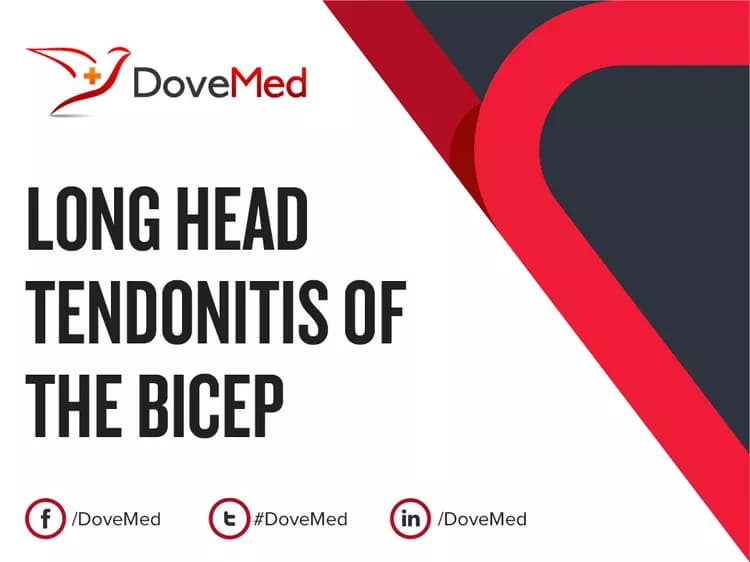What are the other Names for this Condition? (Also known as/Synonyms)
- Biceps Tendinitis
- Bicipital Tendinitis
- Long Head Bicep Tendonitis
What is Long Head Tendonitis of the Bicep? (Definition/Background Information)
- Long Head Tendonitis of the Bicep (or Biceps Tendinitis) is an injury that occurs when the long head biceps tendon, becomes inflamed or irritated
- The long head biceps tendon attaches the bicep muscles to a region of the shoulder, called the supraglenoid tubercle
- Rest, physical therapy, or over-the-counter medications, usually form the initial recommendations to treat the condition. Surgery is an option, if these aforementioned treatment methods are unsuccessful
Who gets Long Head Tendonitis of the Bicep? (Age and Sex Distribution)
- Long Head Tendonitis of the Biceps are non-specific injuries and may occur in all individuals, regardless of age, race/ethnic group, or gender. However, the risk of such an injury increases with age
- Individuals performing certain occupations, athletes participating in any sports, all involving repetitive motions, are at an increased risk of such arm injuries
What are the Risk Factors for Long Head Tendonitis of the Bicep? (Predisposing Factors)
Common risk factors associated with a Long Head Tendonitis of the Bicep include:
- Highly stressful and repetitive activities that are related to sports
- Athletes, who use poor techniques, such as while throwing or performing overhead arm actions, when participating in certain sports, such as baseball or tennis
- Occupations: Occupations that involve a lot of physical activity (heavy lifting, handling of machines/equipment), such as construction, industrial work
It is important to note that having a risk factor does not mean that one will get the condition. A risk factor increases ones chances of getting a condition compared to an individual without the risk factors. Some risk factors are more important than others.
Also, not having a risk factor does not mean that an individual will not get the condition. It is always important to discuss the effect of risk factors with your healthcare provider.
What are the Causes of Long Head Tendonitis of the Bicep? (Etiology)
A majority of Bicep Tendonitis injuries result from athletic sports or physical activities, performed over an extended period of time. As individuals age, the tendons slowly weaken from everyday use. A few causal factors include:
- Excessive overhead lifting or pulling of heavy objects
- Certain sports activities that require a set of repetitive movements for prolonged periods
- Chronic inflammatory disorder (rheumatoid arthritis)
- Degenerative joint disease (osteoarthritis)
What are the Signs and Symptoms of Long Head Tendonitis of the Bicep?
The symptoms are usually mild at the beginning and do not warrant immediate medical attention. There could be a noticeable pain associated with any activities that involve the shoulder/arms. Additional signs and symptoms of a Long Head Tendonitis of the Bicep include:
- Relentless pain in the shoulder, especially with activities that involve overhead lifting
- Radiating pain down the arm
How is Long Head Tendonitis of the Bicep Diagnosed?
Some of the tests a physician may use to help diagnose a Long Head Tendonitis of the Bicep include:
- Physical examination: A thorough physical examination is important in identifying the range of motion, strength, and stability of the arm/shoulder. Individuals are also expected to provide an explanation of the circumstances that caused the injury. In addition to this, a complete medical history can aid in arriving at a definitive diagnosis
- X-rays: X-rays use radiation to produce images of the biceps. This can help your physician rule-out other possible causes for discomfort, such as a fracture
- Magnetic resonance imaging (MRI): An MRI is a more detailed scan that uses radio waves and a magnetic field to generate thorough images of the interior bones and soft tissues around the bicep
Many clinical conditions may have similar signs and symptoms. Your healthcare provider may perform additional tests to rule out other clinical conditions to arrive at a definitive diagnosis.
What are the possible Complications of Long Head Tendonitis of the Bicep?
If Tendonitis of the Long Head of the Biceps is left untreated, the individual is at risk of rupturing the tendon completely. Other complications include:
- Recurrence of the injury without adequate treatment
- Limited range of motion, severely affecting one’s work
How is Long Head Tendonitis of the Bicep Treated?
Nonsurgical treatment:
- Any activity that aggravates the bicep condition should be avoided. The physician may advise the individual to refrain from participating in any physical activities, till the pain or symptoms get better
- Applying ice to the biceps/arm/shoulder can help reduce pain and swelling
- Non-steroidal anti-inflammatory oral medications, such as indomethacin and naproxen, may be used to help decrease the pain and swelling
- Corticosteroid injections into the epidural space (region near the spine, inside the vertebral column) help provide temporary relief of symptoms, and in improving the range of motion. It is important to note that corticosteroid injections only give temporary relief. Prolonged episodes of such injections, may injure the joints in the long-run
- Individuals are likely to need physical therapy exercises. The goals of these exercises are to strengthen the biceps, improve flexibility, and decrease stiffness. It may take several months for an individual to complete the physical therapy program and regain full strength and functionality
If nonsurgical treatment measures are not helpful and they do not relieve the pain, surgery may be recommended.
- Arthroscopy: Arthroscopic surgery is a moderately invasive surgical intervention that is used to repair the tendons using small surgical instruments. These instruments are inserted through a small incision within the shoulder
- Bicep tenodesis: Bicep tenodesis is a surgical intervention technique that involves removal of the damaged bicep tendon. Removing the damaged tendon will usually relieve pain and allow a return to daily/regular activities
- Tenotomy: Tenotomy is a minimally invasive surgical intervention method that involves the removal of a serious damaged tendon. If the long head bicep tendon is damaged beyond repair, a physician may decide to remove the bicep from its attachment
How can Long Head Tendonitis of the Bicep be Prevented?
In individuals with a history of Long Head Bicep Tendonitis, a daily stretching exercise program may help reduce the chances of its recurrence. It is also important to incorporate exercises (into one’s activities) to help strengthen the shoulder. A few other ways would include:
- Avoid any physical activity that require a set of repetitive shoulder movements
- Avoid any repetitive lifting or pulling (especially overhead) of objects that are heavy
- Strengthening the muscles around the biceps, can help reduce the risk of bicep tendonitis
What is the Prognosis of Long Head Tendonitis of the Bicep? (Outcomes/Resolutions)
- With appropriate physical therapy and treatment measures, individuals with Long Head Tendonitis of the Bicep, usually make a full recovery
- However, those with a more severe condition may experience recurrence of the symptoms, even after physical therapy has been completed. The duration for a complete recovery may be prolonged
Additional and Relevant Useful Information for Long Head Tendonitis of the Bicep:
A Shoulder Joint Tear is when the cartilage (the labrum) surrounding the shoulder socket tears. It is also known as Torn Labrum of the Shoulder. Such injuries are very painful and may be the result of any sudden or violent physical activity, or due to overuse of the shoulder.
Related Articles
Test Your Knowledge
Asked by users
Related Centers
Related Specialties
Related Physicians
Related Procedures
Related Resources
Join DoveHubs
and connect with fellow professionals


0 Comments
Please log in to post a comment.